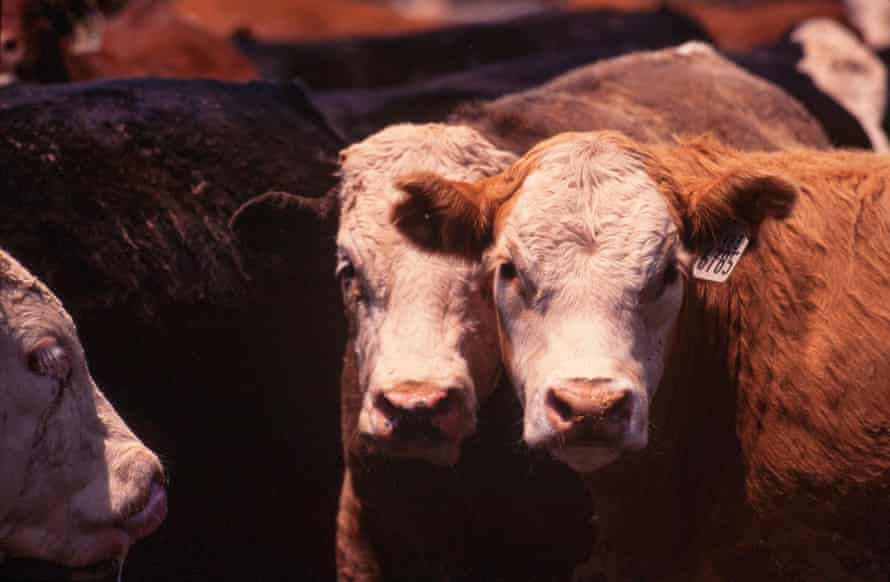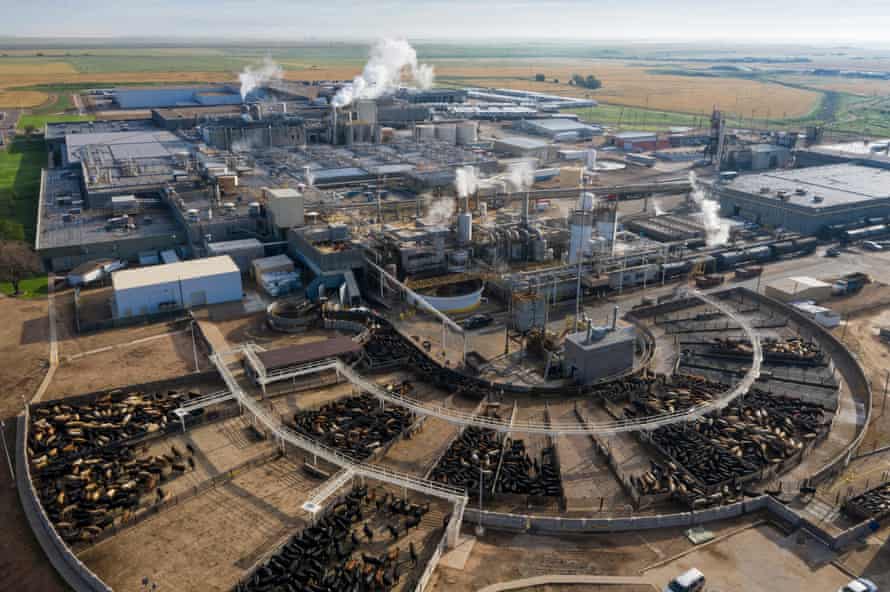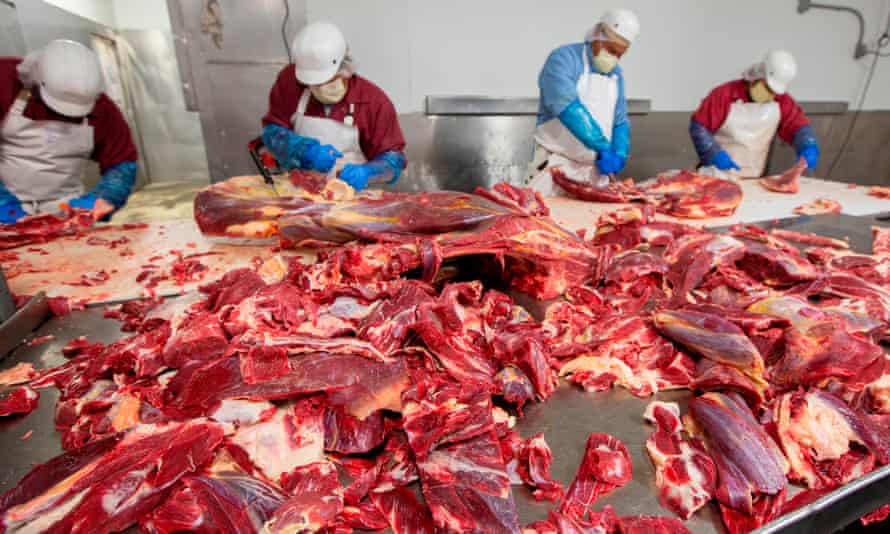Number of Beef Cattle Slaughtered in the Us
B oth the planet and U.s. politics have heated upward in tandem over recent decades, merely few sectors take stewed in controversy quite like America'south beef manufacture. Four super-powered meatpackers control more lxxx% of the US beef market, an extraordinary concentration of marketplace ability that the Biden administration is non happy about. A recent executive action signed past the president aims to increase competition in the beef industry, with the White Firm noting that, over the by five years, "farmers' share of the price of beef sales has dropped by more than than a quarter – from 51.5% to 37.3% – while the price of beef has risen".
But how were the large four meatpackers able to capture so much of the United states beef processing capacity? They had help.
When explaining the history of consolidation in United states of america meatpacking, it is normal to begin in the historic period of Upton Sinclair's 1906 novel The Jungle. In the wake of Sinclair's muckraking exposé on the manufacture of the time, Congress passed the Pure Food and Drug Act and the Federal Meat Inspection Human activity, aimed at cleaning upwardly the meat supply for consumer health and challenging the nearly unrestricted power of these players.
Josh Specht, an environmental and business historian, offers another estimation of this starting indicate. "These acts accustomed the country of the meatpacking industry as of 1906," he writes in his book, Ruddy Meat Republic. "Big meatpacking was no longer questioned, it was regulated."
A third human action, passed in 1921, the Packers and Stockyards Act, was specifically intended to break up the vertical integration of the big companies by forcing them to sell off their interests in businesses that owned, for case, railroads or refrigerated trucks.
This did much to cheque the power of big packers, Specht says, though labour movements of the 1940s and 50s were just as important. Only eventually the industry would revive the old playbook of earning steep turn a profit through immense scale and labour exploitation, and today, all four of the largest beef processors of Sinclair'southward fourth dimension are nonetheless around in some form.

Today's big 4 – Tyson, JBS USA, Cargill and National Beef – are more than than just the heirs to the American meatpacking legacy. They are also multinational giants, two of which are majority-endemic by Brazilian companies. In fact, in 2020, many packers were criticised for the amount of meat that was exported at a time when processing was limited due to Covid outbreaks in processing plants, driving up prices and creating shortages at grocery stores that affected US consumers.
Merely today's big 4 didn't grow into behemoths overnight. In the mid-1970s, they controlled as niggling as 20% of the meatpacking market place. What changed? The answer, in part, lies across the meatpacking sector, with corn farmers and grocery stores.
Information technology's no accident that the 1970s marked the re-ascendance of a concentrated meatpacking industry. The early and mid-70s were a period of explosive growth and high need for agricultural products, when farmers across the country were experiencing some of the highest relative incomes seen in US agriculture, before or since.
During this time, farmers and ranchers with cash to mitt and access to cheap financing were looking to brand investments in their agronomical businesses that would amend cashflow. Specially in the Great Plains, cattle feedlots were but the ticket, requiring relatively limited amounts of country. These years witnessed a boom in the number and size of feedlots, along with advances in antibiotics, feed and cattle genetic technologies.
Past the late 70s and early 80s, market place atmospheric condition led to a dramatic oversupply of grain, and though many farmers suffered historic losses, those who had invested in feedlots were able to buy cheap feed to fatten cattle in their new or expanded bars animal feed operations. These factory-like facilities did what they were meant to do – they helped their owners avoid the downside take chances of producing seasonal and weather-dependent crops.
In 1979, grain-fed cattle deemed for a quarter of the Usa's full beef production, but that number has shot up over the by xl years to more than than 60% today.
The feedlots that constitute the most success tended to exist in the Great Plains, from the Dakotas to Texas, located in a sweetness spot betwixt the midwest's feed grain abundance and the intermountain west's supply of feeder cattle (young cattle weighing 500–600lb, which are brought to market weight in a feedlot).

Meatpackers followed behind these feedlots, which also trended towards consolidation, though not equally dramatically as packers. Today, less than v% of feedlots control 80% of the fed cattle market, most of which are located in merely 5 states.
As the number of cattle suppliers that a given meatpacker had to work with declined, the number of meat buyers also diminished, and their boilerplate size grew.
Past the 90s, consolidation in the US grocery sector was already well nether fashion, with the top 20 food retailers in the country selling nearly 40% of all retail groceries. By 2019, the top four food retailers were capturing that aforementioned xl% of sales, according to the USDA, while in metropolitan areas, their share was over seventy%. Grocery's big four – Walmart, Target, Albertsons and Kroger – are able to exert a surprising corporeality of ability over their suppliers, even over the large 4 meatpackers.
"It's what nosotros call the power of the purchase society," says Errol Schweizer, former vice president of grocery for Whole Foods, now an industry adviser. "Retail buyers have a lot of say over the supply concatenation in terms of their ability to send a purchase social club or withhold the purchase order."
The power of the purchase order is meaning, every bit contracts with major retailers are both extremely competitive and lucrative. The biggest and most centralised meatpackers are usually able to offer the lowest prices to supply retailers with vast and reliable quantities of familiar meat cuts daily, and the fewer meat suppliers a grocery chain works with, the lower their costs of doing business organization. In this way, every bit fewer and fewer grocery chains own more and more of the market, they turn to the fewest and biggest meatpackers, further entrenching a organisation of mega-players all the way through the beef organization.
Just the ascendancy that comes with being a mega-buyer has its limits, equally has been witnessed with continuously climbing beef prices. These increases are a result of Covid-related slowdowns in meatpacking, caused mainly by outbreaks in meatpacking plants that led to thousands of workers falling ill and hundreds dying. Packers passed price increases through to their retail customers, who in plow passed them on to consumers.
The feedlot-packer-grocery mega-group might be showing signs of fraying. In 2020, Walmart fabricated a small-scale step towards taking over some of its own meat processing by opening a new facility in Georgia to make "example-set up" cuts of meat, not dissimilar Costco's 2019 opening of a poultry constitute in Nebraska. This seems to be a sign that big retailers are looking to take back some margin from meatpackers, though currently on a very minor scale.
Nonetheless it happens, many believe that reducing the consolidated power of these large players is critical, non only to keep consumer prices low and ranchers in business, but to protect U.s.a. food security. The global pandemic is not the merely upshot to reveal but how fragile the current consolidated system is – the recent cyber-attack on JBS, which cost the company an $11m (£8m) ransom, halted one-fifth of the US's meat processing capacity for days, with the furnishings felt up and down the supply chain.

Advocates say that if one of the aims of reducing consolidation is to improve protections for workers, particularly the vulnerable meatpacking workers who sickened and died from Covid-xix at rates well beyond the average, the pressure level must exist on the whole food system, not simply meatpacking companies.
"Non one grocery retailer said, 'Hey, this isn't correct'," Schweizer says of retail meat buyers when reports of illness and death related to plants surfaced. Instead, he says, retailers prioritise having meat in stock no matter what, as it'due south an important driver of client loyalty for grocers. But it was well within their power, he says, to withhold or slow down purchases to pressure meatpackers to improve conditions and protect workers.
As pandemic-driven changes to the food system continue to play out, experts will exist carefully watching how the Biden administration attempts to tackle consolidation in the meatpacking sector. Austin Frerick, a Yale-based contest and antitrust skilful, is optimistic that some meaningful steps volition be taken before long, but says what he'due south seen and so far does not break with the historical trend.
"The land of play for the last 40 years," Frerick says of political efforts to break up the big meatpackers, "has been empty words. This is a question of political courage."
Sign upwards for the Animals farmed monthly update to get a roundup of the best farming and nutrient stories across the world and keep up with our investigations. You can ship us your stories and thoughts at animalsfarmed@theguardian.com
muellerraingerred.blogspot.com
Source: https://www.theguardian.com/environment/2021/aug/25/meat-wars-why-biden-wants-to-break-up-the-powerful-us-beef-industry
0 Response to "Number of Beef Cattle Slaughtered in the Us"
Post a Comment